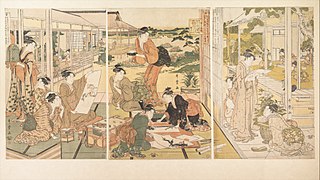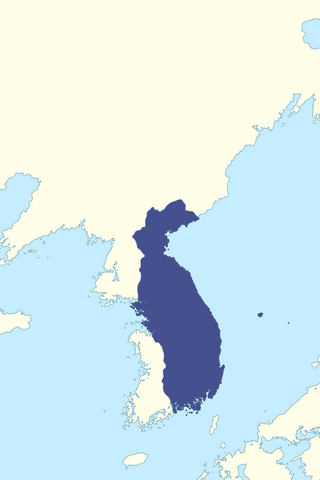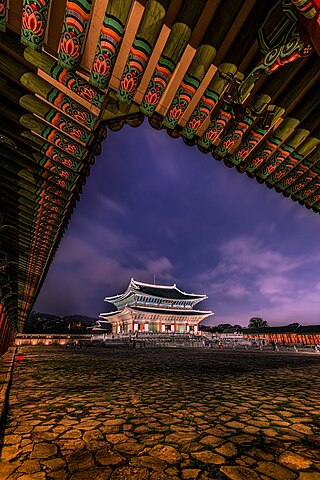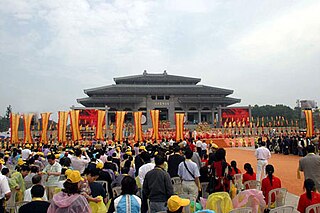
Chinese philosophy originates in the Spring and Autumn period and Warring States period, during a period known as the "Hundred Schools of Thought", which was characterized by significant intellectual and cultural developments. Although much of Chinese philosophy begun in the Warring States period, elements of Chinese philosophy have existed for several thousand years. Some can be found in the I Ching, an ancient compendium of divination, which dates back to at least 672 BCE.

The history of Asia can be seen as the collective history of several distinct peripheral coastal regions such as East Asia, South Asia, Southeast Asia and the Middle East linked by the interior mass of the Eurasian steppe. See History of the Middle East and History of the Indian Subcontinent for further details on those regions.

Korea is a peninsular region in East Asia. In North Korea, both the peninsula and country are called Chosŏn (Korean: 조선). In South Korea, the corresponding term is Hanguk (한국). Since 1945, the peninsula has been divided between the two countries, along what is now the Korean Demilitarized Zone. The region consists of the Korean Peninsula, Jeju Island, and a number of minor islands near the peninsula. The peninsula is bordered by China (Manchuria) to the north and Russia to the northeast, across the Amrok and Duman rivers. It is separated from Japan to the southeast by the Korea Strait.

Taoism or Daoism is a diverse tradition indigenous to China, variously characterized as both a philosophy and a religion. Taoism emphasizes living in harmony with what is known as the Tao—generally understood as being the impersonal, enigmatic process of transformation ultimately underlying reality. The Tao is represented in Chinese by the character 道, which has several related meanings; possible English translations for it include 'way', 'road', and 'technique'. Symbols such as the bagua and taijitu are often employed to illustrate various aspects of the Tao, which can never be sufficiently described with words and metaphors alone. Taoist thought has informed the development of various practices and rituals within the Taoist tradition and beyond, including forms of meditation, astrology, qigong, feng shui, and internal alchemy. A common goal of Taoist practice is self-cultivation resulting in a deeper appreciation of the Tao, and thus a more harmonious existence.

East Asia generally encompasses the histories of China, Japan, Korea, Mongolia, and Taiwan from prehistoric times to the present. Each of its countries has a different national history, but East Asian Studies scholars maintain that the region is also characterized by a distinct pattern of historical development. This is evident in the interrelationship among traditional East Asian civilizations, which not only involve the sum total of historical patterns but also a specific set of patterns that has affected all or most of traditional East Asia in successive layers.

Korean Buddhism is distinguished from other forms of Buddhism by its attempt to resolve what its early practitioners saw as inconsistencies within the Mahayana Buddhist traditions that they received from foreign countries. To address this, they developed a new holistic approach to Buddhism that became a distinct form, an approach characteristic of virtually all major Korean thinkers. The resulting variation is called Tongbulgyo, a form that sought to harmonize previously arising disputes among scholars.

The Three Kingdoms of Korea or Samhan competed for hegemony over the Korean Peninsula during the ancient period of Korean history. During the Three Kingdoms period, many states and statelets consolidated until, after Buyeo was annexed in 494 and Gaya was annexed in 562, only three remained on the Korean Peninsula: Goguryeo, Baekje and Silla. The "Korean Three Kingdoms" contributed to what would become Korea; and the Goguryeo, Baekje and Silla peoples became what we know as the Korean people.

Silla, alternatively Shilla, was a Korean kingdom that existed between 57 BCE – 935 CE and located on the southern and central parts of the Korean Peninsula. Silla, along with Baekje and Goguryeo, formed the Three Kingdoms of Korea. Silla had the lowest population of approximately 850,000 people, which was significantly smaller than those of Baekje and Goguryeo.
Buddhist temples are an important part of the Korean landscape. Most Korean temples have names ending in -sa, which means "temple" in Sino-Korean. Many temples offer visitors a Temple Stay program.

Korean Confucianism is the form of Confucianism that emerged and developed in Korea. One of the most substantial influences in Korean intellectual history was the introduction of Confucian thought as part of the cultural influence from China.

Samguk yusa or Memorabilia of the Three Kingdoms is a collection of legends, folktales and historical accounts relating to the Three Kingdoms of Korea, as well as to other periods and states before, during and after the Three Kingdoms period. "Samguk yusa is a historical record compiled by the Buddhist monk Il-yeon in 1281 in the late Goryeo Dynasty." It is the earliest extant record of the Dangun legend, which records the founding of Gojoseon as the first Korean nation. The Samguk yusa is National Treasure No. 306.

Neo-Confucianism is a moral, ethical, and metaphysical Chinese philosophy influenced by Confucianism, which originated with Han Yu (768–824) and Li Ao (772–841) in the Tang dynasty, and became prominent during the Song and Ming dynasties under the formulations of Zhu Xi (1130–1200). After the Mongol conquest of China in the thirteenth century, Chinese scholars and officials restored and preserved neo-Confucianism as a way to safeguard the cultural heritage of China.

Unified Silla, or Late Silla, is the name often applied to the Korean kingdom of Silla, one of the Three Kingdoms of Korea, after 668 CE. In the 7th century, a Silla–Tang alliance conquered Baekje in the Baekje–Tang War. Silla conquered the southern part of Goguryeo in the 7th century following the Goguryeo–Tang War and Silla–Tang War, unifying the central and southern regions of the Korean peninsula.

Korean architecture refers to an architectural style that developed over centuries in Korea. Throughout the history of Korea, various kingdoms and royal dynasties have developed a unique style of architecture with influences from Buddhism and Korean Confucianism.

Throughout the ages, there have been various popular religious traditions practiced on the Korean peninsula. The oldest indigenous religion of Korea is the Korean folk religion, which has been passed down from prehistory to the present. Buddhism was introduced to Korea from China during the Three Kingdoms era in the fourth century, and the religion pervaded the culture until the Joseon Dynasty when Confucianism was established as the state philosophy. During the Late Joseon Dynasty, in the 19th century, Christianity began to gain a foothold in Korea. While both Christianity and Buddhism would play important roles in the resistance to the Japanese occupation of Korea in the first half of the 20th century, only about 4% of Koreans were members of a religious organization in 1940.

Buddhism has interacted with several Eastern religions such as Taoism, Shinto and Bon since it spread from the Indian subcontinent during the 2nd century AD.
Korean Buddhist sculpture is one of the major areas of Korean art. Buddhism, a religion originating in what is now India, was transmitted to Korea via China in the late 4th century. Buddhism introduced major changes in Korean society. The complexity of the religious sutras sent to Korea required the aristocrats who adopted the religion to become literate and required the training and importation of literate scribes. Little evidence of religious art exists in Korea before the introduction of Buddhism. Subsequent to its introduction, the religion inspired the production of devotional art as well as the beginnings of sophisticated temple architecture.

In the study of comparative religion, the East Asian religions or Taoic religions, form a subset of the Eastern religions. This group includes Chinese religion overall, which further includes Ancestral Worship, Chinese folk religion, Confucianism, Taoism and popular salvationist organisations, as well as elements drawn from Mahayana Buddhism that form the core of Chinese and East Asian Buddhism at large. The group also includes Japanese Shinto, Tenrikyo, and Korean Muism, all of which combine Shamanistic elements and indigenous ancestral worship with various influences from Chinese religions. Chinese salvationist religions have influenced the rise of Japanese new religions such Tenriism and Korean Jeungsanism; as these new religious movements draw upon indigenous traditions but are heavily influenced by Chinese philosophy and theology.
Chinese influence on Korean culture can be traced back as early as the Goguryeo period; these influences can be demonstrated in the Goguryeo tomb mural paintings. Throughout its history, Korea has been greatly influenced by Chinese culture, borrowing the written language, arts, religions, and models of government administration from China, and, in the process, transforming these borrowed traditions into distinctly Korean forms.
Imperial titles were used in various historical Korean states before the 14th century and at the turn of the 20th century: Early Korean states used "great king", "greatest king", and "holy king"; later Korean states used "emperor". Korean monarchs who used imperial titles had political and religious authority over a realm or domain. The Chinese concept of tianxia, pronounced "cheonha" in Korean, was variously adopted and adapted to Korean views of the world from period to period.


















